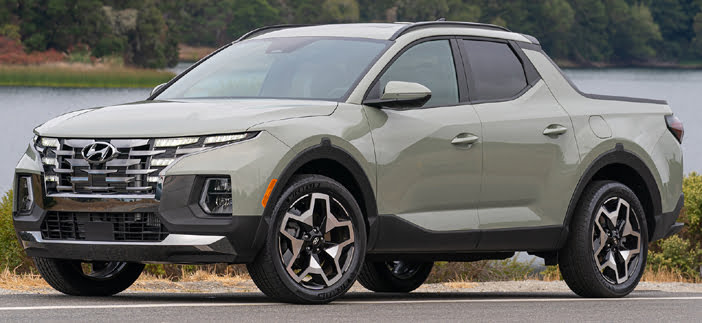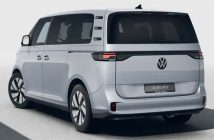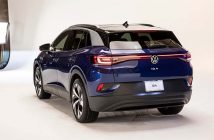+++ J.D. Power has released their U.S. Automotive Performance, Execution and Layout ( APEAL ) study, which found that consumers have fallen in love with a number of new vehicles including the Ford Mustang Mach-E. Designed to measure an “owners’ emotional attachment and level of excitement with their new vehicle”, the study asks them to consider 37 different attributes and their responses are then used to calculate an overall score on a 1.000 point scale. With that basic primer out of the way, let’s dive into the results. One of the key takeaways is mainstream brands have increased their appeal and owner satisfaction to narrow the gap with premium brands. Only 19 points separated them this year, which is down from 23 points a year ago. Dodge was once again named the most appealing mass market brand as they received a score of 882. This puts them on par with Porsche and that’s pretty impressive when you consider Dodge’s lineup isn’t exactly fresh. Interestingly, the brand with the highest appeal is Tesla as they received a score of 893. That’s a small decline from last year, but the automaker isn’t officially ranked because “Tesla doesn’t grant J.D. Power permission to survey its owners in 15 states where it is required”. As a result, the top brands were Porsche and Dodge which tied at 882. They were followed by Ram (881) as well as Genesis (879) and Land Rover (879). On the topic of Genesis, they climbed the most in the premium rankings. Toyota was the biggest mover on the mass market side, while Nissan gained the most index points thanks to a 22 point improvement from a year ago. On the model-level side of things, General Motors had the most winners as the Cadillac CT5, Chevrolet Blazer, Chevrolet Corvette, Chevrolet Tahoe and GMC Sierra HD all got top marks. They were followed by BMW with 4 models including the 4-Series, X4, X6 and X7. Nissan and the Hyundai Motor Group had 3 models receive awards including the Maxima, Sentra and Versa as well as the Genesis G80, Kia K5 (Optima) and Kia Telluride. Rounding out the award winners were the Ford Bronco Sport, Ford Mustang Mach-E, Mercedes CLA, Honda Ridgeline, Land Rover Defender, Ram 1500, Toyota Sienna and Volvo XC40. J.D. Power’s director of global automotive said, “One of the biggest factors driving the industry’s improvement this year is the introduction of several highly appealing new models”, David Amodeo went on to say, “The new launches demonstrate that automakers are getting even better at hitting buyers’ emotional triggers”. +++
+++ Self-driving startup Argo AI, automaker FORD and Walmart stores will soon launch an autonomous vehicle delivery service in Miami, Austin and Washington, the companies said. Initial integration testing is expected to begin later this year, the companies added. The service will use hybrid Ford Escapes (Kuga) fitted with Argo’s self-driving technology to deliver goods to customers who place orders for groceries and other items online. It will operate at one store in each of the 3 markets (presumably with a human backup driver) and provide service within a nearby geographic zone, but is expected to expand to other stores over time. The move comes as consumer expectations shift to next-day or same-day delivery, particularly in urban areas with a higher concentration of deliveries. Argo’s cloud-based system will integrate with Walmart’s online ordering platform to route orders and schedule package deliveries. “Argo and Ford are aggressively preparing for large-scale autonomous vehicle operations across a broad footprint of U.S. cities”, said Scott Griffith, CEO of Ford Autonomous Vehicles & Mobility Businesses, who promised “a great consumer experience”. “This collaboration will further our mission to get products to the homes of our customers with unparalleled speed”, said Tom Ward, senior vice president of last mile delivery at Walmart in the United States. Walmart had previously partnered with GM’s Cruise on a self-driving delivery pilot and with self-driving vehicle startups Gatik and Nuro to explore delivery through autonomous vehicles. Walmart previously tested with Ford in Miami in 2018. Argo and Ford have been testing self-driving technology in Pittsburgh, Detroit and Palo Alto, and have been developing ride-hailing and deliveries in Miami and Washington since 2018 and in Austin since 2019. Ford in the past has partnered with Postmates and Domino’s on autonomous delivery programs. In July, Ford and Argo said they planned a self-driving Lyft ride-hailing program this year in Miami and Austin. +++
+++ In the United States, the C8 Chevrolet Corvette was one of the most hotly-anticipated cars of the past few years and demand was such that it became the bestselling car in the U.S. However, a new vehicle has come to take its throne: the HYUNDAI SANTA CRUZ . Introduced back in April, Hyundai’s unibody pickup truck was a daring release in a market dominated by crossovers and SUVs. Combine that with its unique styling and affordable pricing and it’s not hard to see why it became instantly popular. So popular, in fact, that for the month of August, it stayed just 8 days on dealer lots before selling compared to the Corvette’s 8.3 days. Rounding off the top 10 are the Mercedes-Benz GLS at 8.7 days, the Subaru XV at 9.0 days, the Toyota RAV4 at 9.5 days, the Toyota Sienna at 9.5 days, the Subaru Forester at 9.7 days, the Hyundai Tucson Hybrid at 9.8 days, the Toyota 4Runner at 9.8 days, and the Lexus RX 450h at 9.9 days. Something else worth noting is that while the average Corvette selling price was $89.788 compared to a starting price of $62.195, the average of the Santa Cruz was $34.485 compared to a $23.990 starting price. If we look at the cheapest version of each car compared to the most expensive one, the Hyundai’s average price actually falls closer to higher end, meaning more buyers are likely opting for the more well-equipped models. Obviously there’s no comparison between the 2 as a range-topping Santa Cruz is way more affordable than a fully-loaded C8 Corvette, but it’s an interesting statistic nonetheless. +++

+++ I recently climbed into a BMW with an interior from 10 years ago. I plugged my phone into a USB port, paired it to Bluetooth phone and audio, and quickly selected a song from a playlist using the iDrive knob. This particular car didn’t have blind-spot warning or adaptive cruise control, but with the right options checked, it could have. The materials, from the general plastics to the switchgear and wood trim, are perfectly lovely. The seats: sensational. Oh, there are more gadgets and gizmos, sure. Apple CarPlay and Android Auto can be nice, but they can also cause enough headaches that it can be easier to use the car’s native systems … including a 10-year-old BMW X5’s. There are also more USB ports now and wireless charging, which is pretty clutch with Bluetooth Audio. The screens have all gotten bigger, and have picked up touchscreen capability, but their functionality hasn’t always improved. It’s sometimes gotten worse, especially in the cases of Mercedes-Benz and Lexus. Then there are the screens that are increasingly replacing traditional gauges. Is all that extra info right in front of you really necessary? Is it instead distracting? And in the case of BMW, is the design harder to read? Now, I don’t want to sound too much like an old man yelling at a cloud. This isn’t lamenting the loss of analog purity of old cars in favor of technology-packed new ones. That’s perhaps something you could’ve done back in 2011 about cars that were then 10 years old. Indeed, the difference between a luxury car in 2011 and 2001 was far greater than what we have today between 2021 and 2011. And that’s exactly my point. I’m not sure how much progress has been made recently, at least when compared to past decades. Actually, it’s hard not to wonder if some brands have perhaps gotten a little worse. In the case of interior functionality, all the extra technology can be distracting and confusing. Tasks that were once easy to accomplish with the press of a button can now be head-scratching and/or hair-pulling affairs. I also wonder if the increased reliance on screens in place of switchgear is more about car companies saving money than it is consumer demand and/or the belief they are superior. 2 screens (or 1) has to be a lot cheaper than designing, sourcing and then fitting an analog gauge pack and numerous buttons and knobs. The other question is, do people actually use all the extra stuff added in the past decade? I have serious doubts, especially among older demographics, you know, the people most likely to have the cash needed to buy gadget-packed luxury cars in the first place. My mother doesn’t even know what a podcast is, let alone appreciate that her Mercedes can play one in umpteen different ways. This observation extends to safety tech. While the industry-wide adoption of automatic emergency braking is without question an important advancement, many people (including myself) turn off lane-keeping assist because it’s too intrusive and don’t use adaptive cruise control (not including myself) because they “don’t trust it”. In the case of interior quality, there’s obviously more bling, plus leather or pleather applied to non-seat surfaces, and of course those big, pretty screens. But the overall quality of materials? It’s nothing like the IMPROVEMENTS enjoyed by mainstream brands, where cars like the Nissan Sentra and Hyundai Tucson are bordering on what was once luxury territory. The gap has definitely tightened. Actually, the quality of some luxury brands’ materials have gotten notably worse. The interior of an 2013 modelyear Audi Allroad was of a higher quality than that of a 2021 second generation model; the similarly disappointing Audi Q5 has hard plastics inside on par with what we’d consider unremarkable in a Volkswagen. That wasn’t the case with the original generation. And then there’s the driving experience. Or, perhaps more accurately, the choice of driving experiences. Almost every car nowadays has a menu of drive settings that change steering effort, throttle and transmission response, stability control intervention, and if appropriately equipped, suspension firmness. My old, second-generation X5 is one of the last BMWs to go without such adjustable settings and is better for it. Admittedly, that’s because BMW’s adjustable drive settings found in its other cars from that era were notably poor. However, my X5’s steering is immeasurably more communicative than any non-M BMW of today. The suspension, which isn’t adjustable (though it could’ve been), is on the firm side but beautifully damped and benefits from wheels that aren’t gigantic. The throttle and transmission response? No problems there. I had a similar experience when comparing my old ’13 Allroad to the latest version. Yes, the 2021 has more power and is more efficient, but you have to put it into Sport mode for it to respond in the same way as the old car did, and the old car was hardly sporty. I would rather drive that old Allroad, much as I would rather drive the 10-year-old X5. This is admittedly more a matter of taste, as BMW has clearly chosen to make its cars more customizable and comfort-oriented for a wider range of buyer tastes. I don’t think its cars have gotten better to drive in the past decade, but others might (again, it’s why I kicked this off talking about the interior). At the very least, then, we’re talking about cars being different to drive rather than better. There is a big difference. I must also admit that most of this relates to German luxury brands. Volvo and Lincoln are unquestionably better than they were a decade ago. Every Lexus sold today is much sharper and more responsive to drive. Acura is also making great steps forward, while Genesis has gone from a Hyundai-badged sub-brand to a legitimate heavy hitter in the luxury space. Meanwhile, the in-car technology of some brands, such as Land Rover and Cadillac, is far easier to use. There are other areas to consider. Crash ratings in the past decade really haven’t changed much … only the number of new tests ginned up by the Insurance Institute for Highway Safety. Had engineers needed to make sure its cars passed the same expanded number of tests a decade ago, I’m pretty sure they could’ve gotten it done given how quickly they’ve proven capable of adapting. 2 related areas that have been unquestionably improved are fuel economy and acceleration. Perhaps the engines, be it internal combustion or electrified, are not nearly as characterful as their predecessors. That happens with fewer cylinders and more turbochargers. Yet, we should really stop and appreciate what powertrain engineers have managed to accomplish. As just one data point, a 2013 X5 with the 3.0-liter turbocharged inline-six produced 306 hp and 400 Nm of torque, hit 100 kph in 6.3 seconds, and returned 19 mpg combined. A 2021 X5 with the 3.0-liter turbocharged inline-six produces 340 hp and 450 Nm, hits 100 in 5.5 seconds, and returns 23 mpg combined. That’ll save you upward of $550 on gas every year. And remember, this is a car that went from 6 cylinder to 6 cylinder; the differences between those that downsized and/or added mild hybridization, are even greater. The biggest difference, though, is with the fuel savers. A diesel-powered xDrive35d, was the fuel economy champ of its day at 22 mpg combined, but it is obliterated by today’s: the plug-in hybrid X5 xDrive45e that you can get into for roughly the same price as my car was when new. And that’s without considering tax rebates. Maybe we don’t need or even want much more than what was offered a decade ago. Maybe luxury cars, or at least German ones, were so well-engineered and well-executed a decade ago that there really wasn’t much left to do but put lipstick on a super model. The bar was raised, and it couldn’t go much higher. Alternatively, perhaps all those development dollars are being funneled into electrification efforts like the X5 xDrive45e. Either way, don’t worry too much about buying a 10-year-old luxury car (well, besides maintenance). There’s a decent chance you won’t be missing out on that much. +++
+++ PORSCHE has issued a voluntary recall that applies to the Boxster and the Cayman built between 2012 and 2015. Cars affected by the campaign are fitted with rear axle carrier side sections that can crack. The recall includes Boxster, Boxster S, Boxster GTS, Cayman, Cayman S, and Cayman GTS models manufactured between the 2013 and 2015 model years. Not all models are represented equally; for example, the affected Boxster and Boxster S models were manufactured between September 2012 and July 2014, while the affected GTS cars were built from May to July 2014. What all of these 2-seaters have in common is that they may have been fitted with out-of-specification rear axle carrier side sections, which help connect mechanical bits to the chassis. Porsche noticed the problem in March 2020, and it immediately began testing the part. All told, 10 of the 153 side sections tested were found to be defective; they developed cracks, which could become fractures that might cause the driver to lose control. Porsche will replace the rear axle carrier side sections free of charge in all of the affected cars, regardless of whether cracks have developed in the parts. It will begin notifying owners in November 2021. It adds that the issue can create a ratting noise that’s heard while driving, though it can also go undetected. +++
+++ The TESLA MODEL Y , alongside its Model 3 sibling, hasn’t just made (relatively) affordable electric vehicles desirable, but it has also proven itself to offer very impressive levels of performance. So, how does it fare at the dreaded moose test? The Model Y was recently tested in flagship Performance guise and during the first run, passed the test at 73 km/h. This gave the reviewers the confidence to increase the speed for subsequent runs and in the best attempt, the Model Y passed the moose test at a top speed of 83 km/h. An attempt was made at 84 km/h, but the electric SUV hit one of the cones. During the 83 km/h run, the Model Y Performance initially pushes into slight understeer before the rear-end kicks around to help the car navigate its way through without hitting any cones. It’s an impressive result and matches the 83 km/h run previously performed by a Model 3 Performance, despite the Model Y being an SUV and the Model 3 a sedan. As a reminder, the Tesla Model Y Performance has a pair of electric motors that produce a combined 456 hp and 639 Nm. These motors receive their juice from a 75 kWh lithium-ion battery pack that provides the car with up to 488 km of range. +++
+++ The VOLKSWAGEN Group wants to snatch Tesla’s crown as the world’s largest electric vehicle manufacturer by 2025. The German conglomerate intends on launching approximately 70 battery electric vehicles globally by 2030. Analysts at LMC Automotive say the VW Group is indeed on track to surpass Tesla in EV sales by 2025. In the U.S., Volkswagen currently sells the all-electric ID.4 and will soon follow it up with the ID.Buzz and ID.Aero sedan. The Volkswagen Group also has the advantage of owning a host of different car manufacturers and will eventually have a much larger range of electric vehicles in its range than Tesla. As it stands, the only EVs being produced by Tesla are the Model 3, Model Y, Model S, and Model X, although they will be joined in the future by the Cybertruck, Roadster, and an entry-level model starting at around $25,000. Earlier this year, VW chief executive Herbert Diess joined Twitter and hinted at the brand’s EV ambitions in a tweet directed to Elon Musk. “Hello, @Twitter!” he wrote. “I’m here to make an impact with @VWGroup, especially on political issues. And, of course, to get some of your market shares, @elonmusk – after all, our ID.3 and e-tron have won the first markets in Europe. Looking forward to productive discussions”. +++
+++ China’s Geely Holding is in advanced discussions with banks to list its VOLVO unit in the coming weeks, 3 sources told, in what is expected to be one of Europe’s biggest initial public offerings (IPOs) this year. Volvo is aiming for a valuation of about $20 billion in the planned Stockholm listing, the sources said, with one saying the launch was penciled in for the end of September. Goldman Sachs and SEB are leading the transaction, while other banks including BNP Paribas, Carnegie and HSBC are also involved in the deal, the sources added. Volvo Cars declined to comment. Geely did not immediately respond to an emailed request for comment outside normal business hours in China. SEB and Goldman Sachs declined to comment. The other banks were not immediately available. Geely, which bought Volvo from Ford more than a decade ago in the biggest acquisition by a Chinese firm of a foreign car maker, sought to float shares in the Swedish firm in 2018 but then pulled the deal citing trade tensions and a downturn in automotive stocks. Traditional carmakers have fallen out of favor in recent years, as Tesla has risen to be one of the world’s most valuable companies, putting the focus on electric vehicles. Many European firms have pivoted toward the electric sector, including Volvo, which aims to only make fully electric cars by 2030 and owns a 49.5% stake in electric car maker Polestar. Gothenburg-based Volvo aims to secure a valuation of roughly $20 billion, one of the sources said, while another mentioned a possible range of $20 billion to $30 billion. A third source suggested a $16 billion valuation was more realistic, citing the firm’s revenue outlook. A $20 billion valuation for Volvo would be equivalent to 6 to 7 times its earnings, a level some analysts say is high although it would put it in line with rivals Daimler and BMW. Tesla’s valuation is more than 70 times that. NordLB’s automotive analyst Frank Schwope estimated a valuation range of $10 billion to $15 billion. “The strong margins seen in the first half of 2021 are unlikely sustainable as the market benefited from a strong post-pandemic rebound that is unlikely to continue”, Schwope said. For Geely’s founder Li Shufu, who bought Volvo for $1.8 billion, the listing is a milestone on the road to transport of the future, where cars are part of an electrified network of mobility services generating data and business opportunities. A slew of startups have tapped into the investor frenzy for electric vehicles this year. Rivian, which rolled its first electric pickup truck for a customer off the production line this week, will seek a valuation of about $70 billion to $80 billion when it goes public at the end of this year, sources have told. Nordea chief investment officer John Hernander said the bank was interested in buying Volvo shares if a big enough chunk of the company was sold to keep liquidity high. “That is key. We and many others have been really disappointed in the low liquidity in Traton”, he said, drawing parallels to the 2019 IPO of the truck unit, in which owner Volkswagen floated 11.5 % of the shares. Volvo warned this month that sales volumes in the second half of 2021 could fall year on year after it had been forced to cut production due to material shortages, but otherwise Volvo sales in recent quarters have been a success story. +++



